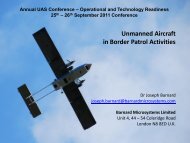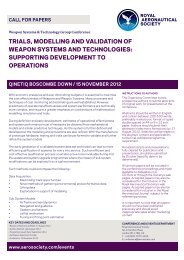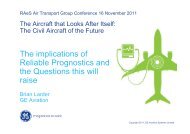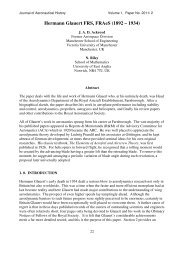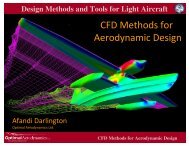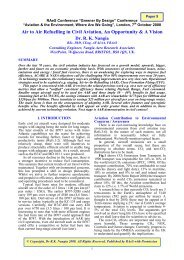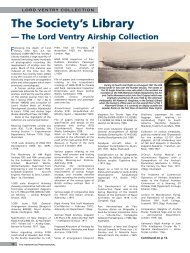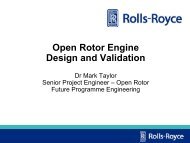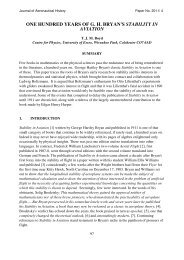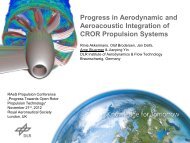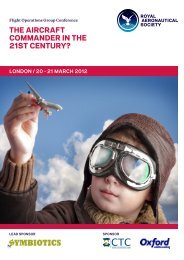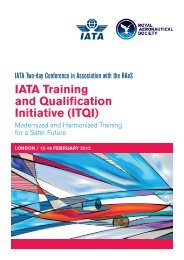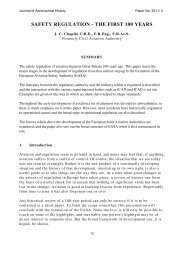Smoke, Fire and Fumes in Transport Aircraft - Royal Aeronautical ...
Smoke, Fire and Fumes in Transport Aircraft - Royal Aeronautical ...
Smoke, Fire and Fumes in Transport Aircraft - Royal Aeronautical ...
Create successful ePaper yourself
Turn your PDF publications into a flip-book with our unique Google optimized e-Paper software.
toward mak<strong>in</strong>g <strong>in</strong>-flight fire less likely <strong>and</strong> provid<strong>in</strong>g the crew with<br />
better means of detect<strong>in</strong>g <strong>and</strong> fight<strong>in</strong>g fires.<br />
Before this accident, the FAA did propose <strong>in</strong> 1975 to amend the<br />
regulations (specifically 14 CFR Part 25.1439) to <strong>in</strong>clude new<br />
st<strong>and</strong>ards for oxygen masks, but withdrew the proposal to allow<br />
further test<strong>in</strong>g to establish the data on which to base st<strong>and</strong>ards 25. In<br />
1981 the FAA advised the NTSB that they <strong>in</strong>tended to update<br />
technical st<strong>and</strong>ard order (TSO) C99 that would provide a m<strong>in</strong>imum<br />
st<strong>and</strong>ard for emergency equipment for “protection of flight crew<br />
members from toxic atmospheres.” 26 The <strong>in</strong>tent of the FAA was to use<br />
an AC to recommend that operators upgrade protective breath<strong>in</strong>g<br />
equipment to the new TSO st<strong>and</strong>ards.<br />
Much of the protective equipment <strong>in</strong> use at that time did not meet the<br />
updated TSO st<strong>and</strong>ard 27. It should be noted that neither a TSO nor an<br />
AC can provide a regulatory requirement for protective breath<strong>in</strong>g<br />
equipment. The NTSB did not believe the FAA’s action was sufficient<br />
to “assure passenger safety.” 28<br />
The FAA did not immediately implement the NTSB recommendations<br />
one of which was regard<strong>in</strong>g lavatory fire detectors until after the Air<br />
Canada Flight 797 accident <strong>in</strong> June 1983. In addition to action on<br />
lavatory smoke detectors <strong>and</strong> protective breath<strong>in</strong>g equipment (PBEs),<br />
other safety enhancements resulted from NTSB recommendations<br />
from Air Canada Flight 797. New emergency light<strong>in</strong>g st<strong>and</strong>ards <strong>and</strong><br />
recommendations were advised. The Board recommended tactile<br />
aisle markers <strong>and</strong> floor light<strong>in</strong>g so that people <strong>in</strong>side a smoke filled<br />
cab<strong>in</strong> could locate an emergency exit by feel alone. Improvements <strong>in</strong><br />
fire block<strong>in</strong>g material (this required the retrofit of 650,000 seats) to<br />
slow fire propagation <strong>and</strong> emergency exit light<strong>in</strong>g requirements,<br />
became a requirement <strong>in</strong> 1986 29.<br />
Lavatory fires cont<strong>in</strong>ued to occur, caus<strong>in</strong>g the NTSB to recommend<br />
smoke detectors <strong>and</strong> automatic discharge fire ext<strong>in</strong>guishers <strong>in</strong> the<br />
waste receptacles. The FAA implemented the NTSB 1974<br />
recommendation (A74-98) for m<strong>and</strong>at<strong>in</strong>g automatic discharge fire<br />
ext<strong>in</strong>guishers <strong>in</strong> the lavatory waste receptacle after Air Canada Flight<br />
797’s fire <strong>in</strong> 1983 30. Also, <strong>in</strong> 1986 the FAA required that at least two<br />
Halon fire ext<strong>in</strong>guishers be <strong>in</strong> the cab<strong>in</strong> 31.<br />
On 29 July 1986 the FAA issued AC 25-9 to provide guidel<strong>in</strong>es for<br />
certification tests of smoke detection, penetration, evacuation tests<br />
<strong>and</strong> flight manual emergency procedures 32. The AC specifically cites<br />
cont<strong>in</strong>uous smoke as a condition that should be considered <strong>in</strong> the<br />
formulation of smoke <strong>and</strong> fire procedures. It cited that accidents<br />
statistics show there are conditions of cont<strong>in</strong>uous fire <strong>and</strong> smoke <strong>in</strong>flight.<br />
Interest<strong>in</strong>gly, the AC test procedure for flight deck smoke<br />
evacuation states that the smoke generation should be term<strong>in</strong>ated<br />
after the flight <strong>in</strong>struments are obscured. However, all other tests cited<br />
<strong>in</strong> AC 25-9 require cont<strong>in</strong>uous smoke be used 33. The ventilation<br />
systems are allowed three m<strong>in</strong>utes to clear the smoke so that a pilot<br />
can see the <strong>in</strong>struments. This test does not represent conditions<br />
where smoke cont<strong>in</strong>ues to be produced.<br />
Air Canada Flight 797 experienced cont<strong>in</strong>uous smoke caus<strong>in</strong>g the<br />
Capta<strong>in</strong> to l<strong>and</strong> with his oxygen mask <strong>and</strong> smoke goggles on <strong>and</strong> his<br />
face pressed aga<strong>in</strong>st the w<strong>in</strong>dshield 34. Other cases of cont<strong>in</strong>uous<br />
smoke <strong>in</strong> the flight deck <strong>in</strong>clude an Air Europe Fokker 100 l<strong>and</strong><strong>in</strong>g at<br />
Copenhagen on 17 December 1989, Varig Flight 860, Pan American<br />
Flight 160 <strong>and</strong> Air Tran Flight 913 35. The Air Europe flight experienced<br />
dense smoke so thick that the pilots could not see each other 36. There<br />
is evidence that cont<strong>in</strong>uous smoke can occur <strong>in</strong> transport aircraft flight<br />
decks, yet the flight deck ventilation tests do not require that<br />
cont<strong>in</strong>uous smoke be present.<br />
To further exp<strong>and</strong> the scope of smoke test<strong>in</strong>g a draft of an update to<br />
AC 25-9 began to circulate the <strong>in</strong>dustry for comment <strong>in</strong> July 1992. The<br />
revision <strong>in</strong>cluded recommendations for:<br />
Addition of regulatory amendments for improved smoke clearance<br />
procedures;<br />
Adherence to updated Part 25 requirements;<br />
<strong>Fire</strong> protection;<br />
Lavatory fire protection;<br />
Addition of crew rest area smoke detector certification test;<br />
Use of helium smoke generator <strong>in</strong> test<strong>in</strong>g; <strong>and</strong><br />
Cont<strong>in</strong>uous smoke generation <strong>in</strong> the cockpit smoke evacuation<br />
tests 37.<br />
The f<strong>in</strong>al version of AC 25-9a was published on 6 January 1994.<br />
While most of the issues <strong>and</strong> test<strong>in</strong>g criteria were similar, there were<br />
changes from the draft. The revision from the orig<strong>in</strong>al AC <strong>in</strong>cluded<br />
recommendations for additional regulatory amendments for improved<br />
smoke clearance procedures, adherence to updated Part 25<br />
requirements, fire protection, lavatory fire protection, addition of crew<br />
rest area smoke detector certification test, use of helium smoke<br />
generator <strong>in</strong> test<strong>in</strong>g <strong>and</strong> paper towel burn box smoke generator, but<br />
not cont<strong>in</strong>uous smoke <strong>in</strong> the flight deck test<strong>in</strong>g. Cont<strong>in</strong>uous smoke <strong>in</strong><br />
the flight deck was referred to <strong>in</strong> Paragraph 6c (8): “Although the<br />
FAR 38 does not require the consideration of cont<strong>in</strong>uous smoke<br />
generation/evacuation, the FAA recommends that the airframe design<br />
address this situation. Accord<strong>in</strong>gly, paragraphs 12a (1) <strong>and</strong> 12e (3)<br />
recommend address<strong>in</strong>g cont<strong>in</strong>uous smoke generation/evacuation <strong>in</strong><br />
the cockpit.” 39 The previous test procedure, which term<strong>in</strong>ates the<br />
generation of smoke, rema<strong>in</strong>ed. Rationale for the return to the<br />
previous method of test<strong>in</strong>g was not expla<strong>in</strong>ed <strong>in</strong> the revised AC.<br />
The FAA testified before Congress on 8 November 1993 just before<br />
the f<strong>in</strong>al version of the AC was released. Dur<strong>in</strong>g that testimony they<br />
stated: “The evacuation of smoke from a cockpit is needed to enable<br />
the crew to operate the aircraft. Our st<strong>and</strong>ards provide for the<br />
effective evacuation of smoke. An aircraft’s equipment <strong>and</strong><br />
procedures are considered to meet FAA requirements if smoke<br />
concentration is reduced with<strong>in</strong> three m<strong>in</strong>utes, so that any residual<br />
smoke neither distracts the flight crew nor <strong>in</strong>terferes with operations<br />
under either <strong>in</strong>strument meteorological conditions, IMC or visual<br />
meteorological conditions, VMC. We believe these st<strong>and</strong>ards provide<br />
sufficient reserve for a flight crew to reta<strong>in</strong> adequate visibility of the<br />
flight <strong>in</strong>struments <strong>and</strong> controls <strong>and</strong> outside the aircraft, to cont<strong>in</strong>ue<br />
safe flight <strong>and</strong> l<strong>and</strong><strong>in</strong>g even when a reasonably probable cont<strong>in</strong>uous<br />
smoke source is present.” 40<br />
However, this was not consistent with the experience of Federal<br />
Express Flight 1406 (a DC-10 that l<strong>and</strong>ed <strong>and</strong> burned on 5<br />
September 1996), Swissair Flight 111 (MD-11 that crashed after a<br />
major <strong>in</strong>-flight fire on 2 September 1998, described later <strong>in</strong> the paper),<br />
or Air Tran Flight 913, which experienced an <strong>in</strong>-flight fire on 8 August<br />
2000 41. The fires aboard these aircraft burned <strong>and</strong> the crew could not<br />
ext<strong>in</strong>guish or evacuate the smoke, so it spread.<br />
Interior Material Toxicity <strong>and</strong> Flammability<br />
The flammability of material <strong>in</strong> the <strong>in</strong>terior of the cab<strong>in</strong> became a<br />
concern as toxic fumes were found to be released dur<strong>in</strong>g cab<strong>in</strong> fires.<br />
Therefore, improvements to flammability st<strong>and</strong>ards were proposed.<br />
The FAA, work<strong>in</strong>g with safety recommendations from the NTSB,<br />
began a major improvement <strong>in</strong> cab<strong>in</strong> <strong>in</strong>teriors follow<strong>in</strong>g the fires<br />
aboard Varig Flight 860 <strong>and</strong> Pan American Flight 160. In 1972 a<br />
United Air L<strong>in</strong>es B737 crashed near Chicago’s Midway airport. Some<br />
of the victims of the accident, <strong>in</strong>clud<strong>in</strong>g (well known Watergate<br />
personality) Howard Hunt’s wife, showed high levels of cyanide <strong>in</strong><br />
their blood stream 42. This high visibility accident helped show the<br />
need for improvement <strong>in</strong> the toxicity of cab<strong>in</strong> <strong>in</strong>teriors. The dem<strong>and</strong><br />
for improvement led to the creation of the Special Aviation <strong>Fire</strong> <strong>and</strong><br />
Explosion Reduction (SAFER) Advisory Committee <strong>in</strong> May 1978, an<br />
advisory committee which helped def<strong>in</strong>e the types of research<br />
needed <strong>in</strong> fire safety <strong>and</strong> the issues of <strong>in</strong>terior material toxicity <strong>and</strong><br />
flammability for <strong>in</strong>-flight <strong>and</strong> post crash fires 43.<br />
FEBRUARY 2007 9



